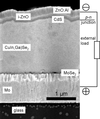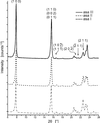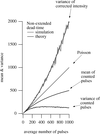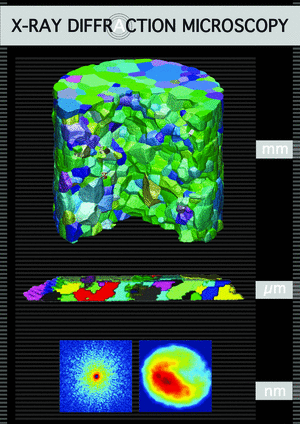issue contents
October 2007 issue

Cover illustration: Molecular electrostatic potential of thymidine mapped on the charge density isosurface at 0.5 e Å-3 using MolIso. Courtesy of C. B. Huebschle & P. Luger [J. Appl. Cryst. (2006), 39, 901-904].
research papers
Data reduction practice in X-ray reflectometry is described. The several approaches for applying certain corrections, such as background subtraction, geometrical effects and normalization, are compared and discussed.
Data analysis methods for specular X-ray and neutron reflectivity are compared. Genetic algorithms behave particularly well for relatively simple systems, but for more complicated systems, semi ab initio methods are needed to obtain the number of layers required to be used with the genetic algorithm.
A Patterson deconvolution procedure is applied to powder diffraction data. Its efficiency is compared with the performance of direct methods.
The grain-size distributions obtained from electron-backscatter diffraction maps acquired on various chalcopyrite-type thin-film cross sections are represented well by lognormal distribution functions. The most frequent grain-boundary types in these thin films are 60°−〈221〉tet and 71°−〈110〉tet (near) Σ3 twin boundaries.
Four different ferrite/cementite orientation relationships in near-eutectoid steel are derived using SEM–FEG/EBSD (scanning electron microscopy–field emission gun/electron back-scatter diffraction) and an indirect two-trace method. The present results may give deep insight into the crystallography of pearlitic transformation and provide useful information for materials design through interface tailoring in steels.
The compacts with a higher degree of texture had clearly lower intrinsic dissolution rate than the compacts with a lower degree of preferred orientation. It was also found that by using the results of the texture measurements, the particle habit of the compacted powder could be predicted.
A method is described that combines scanning microdiffraction techniques, Rietveld quantitative phase analysis and a statistical method known as canonical correlation analysis, to provide a two-dimensional mapping of phase concentrations.
Grazing-incidence X-ray diffraction is shown to be a direct tool for measuring the elastic displacement modes near the surface of a crystal. Applications of such measurements are performed on self-organized and vicinal surfaces.
The Patterson deconvolution method for ab initio protein phasing has been improved to cope with low-resolution data and light-atom structures.
This paper reviews the various methods by which the strain-free lattice parameter can be determined or inferred for a polycrystalline material. This is an essential, and often the most difficult, step in the determination of residual stresses using the diffraction method.
An X-ray imaging geometry is presented that enables nondestructive, high-resolution tomographic characterization of individual grains in the bulk of polycrystals.
Innovations in high-pressure macromolecular crystallography allow this method to be applied in a pressure range extended beyond 2 GPa to crystals with very anisotropic habit and/or low-symmetry space group.
Measurements of the optical rotation of LiB3O5 have been carried out along a birefringent section. The relationship between structure and optical properties of the material has been established.
The characteristics of threading dislocations in ZnO epitaxial films grown on c-plane sapphire were investigated by X-ray diffraction and transmission electron microscopy. The structural properties obtained together with the capacitance signals measured by scanning capacitance microscopy provide an insight into the role of threading dislocations in governing the electrical properties of ZnO epi-films.
The `free lunch method' (non-measured reflection extrapolation) has been characterized and made more effective.
The focus of this paper is on the design, analysis, implementation and deployment of grid-based versions of SnB and BnP, programs based on the Shake-and-Bake method of molecular structure determination from X-ray diffraction data.
The design and characteristics of a double-supermirror monochromator for neutron instrumentation are described.
A grazing-incidence X-ray scattering (GIXS) formula is derived for gyroid structures in substrate-supported thin films. Two-dimensional GIXS measurements were carried out for gyroid structures developed in polystyrene-b-polyisoprene diblock copolymer thin films supported on silicon substrates, and a quantitative analysis of the two-dimensional GIXS data was demonstrated successfully by using the scattering formula.
short communications
An Ewald construction is applied to small-angle neutron scattering experiments from line-like objects, such as superconducting flux line lattices. The resolution function for rocking-curve measurements is derived from the beam collimation and wavelength spread.
The statistical properties of the counting loss based on conventional non-extended and extended dead-time models are examined by a Monte Carlo method. Practical formulae to estimate the statistical errors of the corrected intensities are also presented.
computer programs
A program developed to aid the interpretation of X-ray fibre diffraction data is described. The program enables manipulation of the data, data processing and diffraction simulation from model coordinates.


 journal menu
journal menu








































